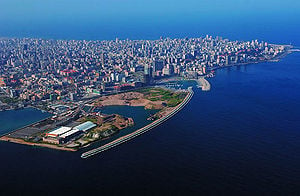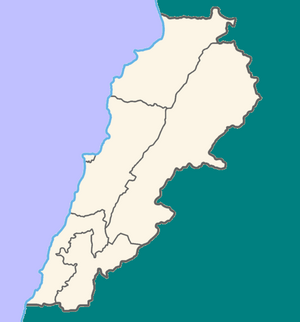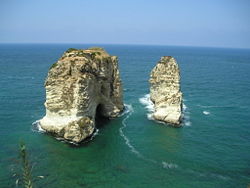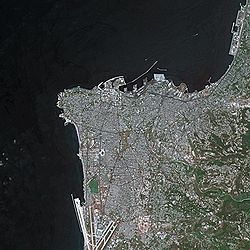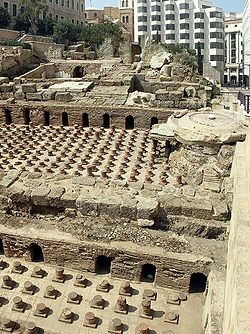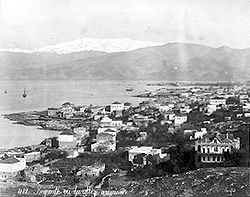Difference between revisions of "Beirut" - New World Encyclopedia
Mary Anglin (talk | contribs) (→References: alpha order) |
Mary Anglin (talk | contribs) (→Government: gallery) |
||
| Line 114: | Line 114: | ||
==Government== | ==Government== | ||
| − | |||
| − | |||
| − | |||
| − | |||
The Lebanese Republic has a parliamentary democracy in which the highest offices are proportionately reserved for representatives from various religious communities to minimize sectarian conflict – a framework known as “confessionalism.” The chief of state is the president, who is elected by the National Assembly for a six-year term. The head of government is the prime minister, who, with the deputy prime minister, is appointed by the president in consultation with the 128-seat [[National Assembly]]. | The Lebanese Republic has a parliamentary democracy in which the highest offices are proportionately reserved for representatives from various religious communities to minimize sectarian conflict – a framework known as “confessionalism.” The chief of state is the president, who is elected by the National Assembly for a six-year term. The head of government is the prime minister, who, with the deputy prime minister, is appointed by the president in consultation with the 128-seat [[National Assembly]]. | ||
| Line 127: | Line 123: | ||
The city is home to numerous international organizations. The [[United Nations]] [[ESCWA|Economic and Social Commission for Western Asia]] (ESCWA) is headquartered in Downtown Beirut, while the [[International Labour Organization]] (ILO) and [[UNESCO]] (United Nations Educational, Scientific and Cultural Organization) both have regional offices in Beirut covering the [[Arab world]]. The [[Arab Air Carriers Organization]] (AACO) is also headquartered in Beirut. | The city is home to numerous international organizations. The [[United Nations]] [[ESCWA|Economic and Social Commission for Western Asia]] (ESCWA) is headquartered in Downtown Beirut, while the [[International Labour Organization]] (ILO) and [[UNESCO]] (United Nations Educational, Scientific and Cultural Organization) both have regional offices in Beirut covering the [[Arab world]]. The [[Arab Air Carriers Organization]] (AACO) is also headquartered in Beirut. | ||
| + | |||
| + | <center><gallery> | ||
| + | Image:Beirut city hall.jpg|Facade of the Beirut City Hall | ||
| + | Image:UNbeirut.jpg|thumb|United Nations headquarters in Beirut | ||
| + | Image:Grand serail solidere 4.jpg|The Grand Serail | ||
| + | Image:BeirutParliament.jpg|Lebanese House of Speakers | ||
| + | <gallery></center> | ||
== Economy == | == Economy == | ||
Revision as of 20:15, 29 July 2008
| Beirut بيروت Beyrouth (French) |
|
| Location in Lebanon. The surrounding district can be seen on the map. | |
| Coordinates: {{#invoke:Coordinates|coord}}{{#coordinates:33|53|13|N|35|30|47|E|type:city | |
|---|---|
| name= }} | |
| Country | |
| Governorate | Beirut, Capital City |
| Government | |
| - Mayor | Abdel Mounim Ariss[1] |
| Area | |
| - City | 200 km² (31 sq mi) |
| Population (2007) | |
| - City | 1 700 000 |
| - Density | 12,500/km² (32,374.9/sq mi) |
| - Metro | + 2 000 000 |
| Time zone | +2 (UTC) |
| - Summer (DST) | +3 (UTC) |
| Website: City of Beirut | |
Beirut (Arabic: بيروت, Bayrūt, Greek: Βηρυττός Viryttós, French: Beyrouth, Syriac: ܒܝܪܘܬ) is the capital and largest city of Lebanon. The first mention of the city is found in the ancient Egyptian Tell el Amarna letters, dating to the 15th century B.C.E., and the city has been continuously inhabited over the centuries since. Excavations in the downtown area have unearthed layers of Phoenician, Hellenistic, Roman, Arab and Ottoman remains.
Beirut is one of the most religiously diverse cities of the Middle East, and the city has had a history of political strife due to a roughly even division between Christians and Muslims. The city is home to four of the 12 official Palestinian refugee camps in Lebanon.
After the destructive Lebanese civil war, Beirut was reconstructed, and the redesigned historic city center, marina, pubs, and nightlife districts have made it a popular tourist attraction. Beirut holds Lebanon's seat of government, plays a central role in the Lebanese economy, and is renowned for its press, theaters and cultural activities.
Geography
Located on a peninsula that extends west at the midpoint of Lebanon's coastline with the Mediterranean sea, Beirut serves as the country's main seaport and forms the Beirut District. Flanked by the Lebanon mountains, the city has taken on a triangular shape, largely influenced by its situation between and atop two hills: Al-Ashrafieh and Al-Musaytibah. Beirut's coast consists of rocky beaches, sandy shores, and cliffs.
The Beirut Governorate area covers 6.9 square miles (18 square kilometers), and the city's metropolitan area covers 26 square miles (67 square kilometers).
Beirut has a Mediterranean climate characterized by a hot and humid summer, pleasant fall and spring, and a cool, rainy winter. August is the hottest month with an average high temperature of 85°F (29°C). January and February are the coldest months with an average low temperature of 50°F (10°C). During the afternoon and evening the prevailing wind direction is onshore, from the west, while at night the wind direction reverses to offshore, from the land.
Winter is the rainy season, with most precipitation falling after December. The average annual rainfall is 34.1 inches (860mm), falling in heavy cloudbursts in winter.
Air pollution from car exhausts and private electricity generators, inadequate waste disposal, deforestation, and excessive removal of beach sand are among environmental problems facing Beirut.
History
Originally named Bêrūt, The Wells, which refers to the underground water supply there, by the Phoenicians, Beirut's history goes back more than 5000 years. Excavations in the downtown area have unearthed layers of Phoenician, Hellenistic, Roman, Arab and Ottoman remains.
The first historical reference to Beirut dates from the 14th century B.C.E., when it was mentioned in the cuneiform tablets of the "Amarna letters," whenAmmunira of Biruta(Beirut) sent three letters to the pharaoh of Egypt. Biruta is also referenced in the letters from Rib-Hadda of Byblos. The most ancient settlement was on an island in the river that progressively silted up. The city was known in antiquity as Berytus.
In 140 B.C.E., Diodotus Tryphon seized and destroyed the city in his contest with Antiochus VII Sidetes for the throne of the Seleucid monarchy. Beirut was soon rebuilt on a more regular Hellenistic plan, renamed Laodicea in Phoenicia or Laodicea in Canaan, in honor of a Seleucid Laodice.
Mid-first century coins of Berytus bear the head of Tyche, goddess of fortune. On the reverse, the city's symbol appears: a dolphin entwines an anchor.
Beirut was conquered by Agrippa in 64 B.C.E. and the city was renamed in honor of the emperor's daughter, Julia; its full name became Colonia Julia Augusta Felix Berytus. The veterans of two Roman legions were established in the city: the fifth Macedonian and the third Gallic. The city quickly became Romanized. Large public buildings and monuments were erected and Berytus enjoyed full status as a part of the empire.
Under the Romans, it was enriched by the dynasty of Herod the Great (73 B.C.E.- 4 B.C.E.), and was made a colonia, Colonia Iulia Augusta Felix Berytus, in 14 B.C.E., Beirut's school of law was widely known at the time. Two of Rome's most famous jurists, Papinian and Ulpian, both natives of Phoenicia, taught at the law school under the Severan emperors.
When Justinian (483-565) assembled his Pandects in the sixth century, a large part of the corpus of laws were derived from these two jurists, and Justinian recognized the school as one of the three official law schools of the empire (533). Within a few years, as the result of a disastrous earthquake (551), the students were transferred to Sidon. About 30,000 were killed in Berytus alone and, along the Phoenician coast, total casualties were close to 250,000.
Beirut passed to the Arabs in 635. As a trading centre of the eastern Mediterranean, Beirut was overshadowed by Akka during the Middle Ages.
From 1110 to 1291 it was in the hands of the Crusaders. No matter who was its nominal overlord, whether Turk or Mamluk, Beirut was ruled locally by Druze emirs. One of these, Fakr ed-Din Maan II (1572-1635), fortified it early in the 17th century.
The Ottomans retook it in 1763 and thenceforth, with the help of Damascus, Beirut successfully broke Akka's monopoly on Syrian maritime trade and for a few years supplanted it as the main trading centre in the region.
During the succeeding epoch of rebellion against Ottoman hegemony at Akka under Jezzar (1720-1804) and Abdullah pashas, Beirut declined to a small town (population about 10,000), and was fought over among the Druze, the Turks, and the pashas.
After Ibrahim Pasha (1789–1848) captured Akka in 1832, Beirut began its early modern revival. In 1888, Beirut was made capital of a vilayet in Syria, including the sanjaks Latakia, Tripoli, Beirut, Akka and Bekaa. Beirut became a cosmopolitan city and had close links with Europe and the United States.
Beirut became a centre of missionary activity, which was generally unsuccessful in conversions (a massacre of Christians in 1860 was the occasion for further European interventions), but did build an impressive education system. This included the Syrian Protestant College, which was established by American missionaries and eventually became the American University of Beirut.
Beirut became the centre of Arab intellectual activity in the 19th century. Provided with water from a British company and gas from a French one, the city thrived on exporting silk grown on nearby Mount Lebanon.
After French engineers established a modern harbor in 1894, and a rail link across Lebanon to Damascus, and then to Aleppo in 1907, much of the trade was carried by French ships to Marseille, and soon French influence in the area exceeded that of any other European power. In 1911, the population mix was reported in the Encyclopædia Britannica as Muslims, 36,000; Christians, 77,000; Jews, 2500; Druze, 400; foreigners, 4100.
After the collapse of the Ottoman Empire following World War I (1914-1918), Beirut, along with all of Lebanon was placed under the French Mandate.
Lebanon achieved independence in 1943, and Beirut became its capital city, and remained the intellectual capital of the Arab world, and a major commercial and tourist center, until 1975 when a brutal civil war broke out in Lebanon.
In response to an attack on an El Al jet in Athens, on the night of December 28, 1968, Israeli commandos mounted a surprise attack on the airport and destroyed 13 civilian aircraft belonging to the Lebanese carriers, Middle East Airlines.
During most of the war, the city was divided between the largely Muslim west part and the Christian east. The central area of the city, previously the focus of much of the commercial and cultural activities, became a no man's land. Many of the city's inhabitants fled to other countries. In 1983, French and US barracks were bombed, killing 302.
Since the end of the war in 1990, the people of Lebanon have been rebuilding Beirut, and by the start of the 2006 Israel-Lebanon conflict the city had somewhat regained its status as a tourist, cultural, and intellectual center in the Middle East, as well as a center for commerce, fashion, and media. However, many would say the city has lost its premier status, due to competition from places like Dubai and Cyprus in the fields of tourism, business, fashion, commerce, and banking. Reconstruction of downtown Beirut has been largely driven by Solidere, a development company established in 1994 by Rafik Hariri.
The 2005 assassination of former Lebanese Prime Minister Rafik Hariri near the Saint George Bay in Beirut shook the entire country. Approximately one million people gathered for an opposition rally in Beirut, a month after the death of Hariri. The "Cedar Revolution" was the largest rally in Lebanon's history. The last Syrian troops withdrew from Beirut on April 26, 2005.
Since the modern city overlies the ancient one, little archaeology had been done until after the end of the civil war in 1991. A dig in 1994 established that one of Beirut's modern streets, Souk Tawile, follows the lines of an ancient Hellenistic/Roman street.
Government
The Lebanese Republic has a parliamentary democracy in which the highest offices are proportionately reserved for representatives from various religious communities to minimize sectarian conflict – a framework known as “confessionalism.” The chief of state is the president, who is elected by the National Assembly for a six-year term. The head of government is the prime minister, who, with the deputy prime minister, is appointed by the president in consultation with the 128-seat National Assembly.
The Beirut is one of six mohafazah (state governorates; mohafazat, singular), with the others being Beqaa, North Lebanon, South Lebanon, Mount Lebanon, and Nabatiye.
Beirut is divided into 12 neighborhoods. These are: Ashrafieh, Beshoura, Dar el Mreyseh, Marfa’, Mazra’a, Mdawar, Mina El Hosson, Msaytbeh, Ras Beirut, Rmeil, Saifi, and Zkak El Blat.
Four of the 12 official Palestinian refugee camps in Lebanon are located in Beirut. These are: Burj el-Barajneh, Dbayeh, Mar Elias, and Shatila. Of the 15 unregistered or unofficial refugee camps, Sabra, which lies adjacent to Shatila, is located in Beirut.
The city is home to numerous international organizations. The United Nations Economic and Social Commission for Western Asia (ESCWA) is headquartered in Downtown Beirut, while the International Labour Organization (ILO) and UNESCO (United Nations Educational, Scientific and Cultural Organization) both have regional offices in Beirut covering the Arab world. The Arab Air Carriers Organization (AACO) is also headquartered in Beirut.
- == Economy ==
- Per capita GDP was $6681 in 2006, giving Lebanon a rank of 90 on a list of 181 countries. The unemployment rate was 20 percent in 2006.
- ==Demographics==
- Arabs make up 95 percent of the population, Armenians four percent, others one percent.
- Lebanon's official language is Arabic, but French, Armenian, and English are widely spoken. Many Lebanese speak a patois of some combination of these four languages, most commonly an Arabic-French mixture. Virtually all Lebanese are bilingual.
- The higher education system is based on the Baccalauréat libanais, but the Baccalauréat Français is accepted as an equivalent. Before being admitted to any higher education institution, one must achieve his or her Baccalauréat examinations.
- ==Of interest==
- * The Corniche, a long seaside promenade, which is a public gathering space with wonderful views of the coast.
- * Pigeon Rocks, rock formations in a cove in Raouche.
- * The St George Greek Orthodox Cathedral, and the St George Maronite Cathedral.
- * The Roman Baths, and other downtown archaeological sites, which are being restored for public viewing.
- * The smaller American University of Beirut Archaeology Museum, which is the third oldest museum in the Middle East, it exhibits a wide range of artifacts from Lebanon and neighboring countries
- * Ashrafieh, where the Sursock Museum is located, is a neighbourhood with narrow, winding streets and some beautiful old residences.
- * Hamra, south of the American University, is a good place to soak up the city's daily life.
- == Gallery ==
- Place des Martyrs Statue silhouette.jpg
Martyrs statue
- BeirutAlOmari.jpg
Mohammad al-Amin Mosque
Notes
- ↑ Word from the President, Beirut.gov.lb
ReferencesISBN links support NWE through referral fees
- El-Rayes, Nathalie Antoine. 1997. The role of the port of Beirut in the Lebanese economy: past performance and future development. Beirut: American University of Beirut. OCLC 43318041
- Encyclopædia Britannica Online. 2008. Beirut Retrieved July 26, 2008.
- Hall, Linda Jones. 2004. Roman Berytus Beirut in late antiquity. London: Routledge. ISBN 9780203499078
- Jehl, Douglas. February 23, 1997. Under Beirut's Rubble, Remnants of 5000 Years of Civilization The New York Times. Retrieved July 24, 2008.
- Jidejian, Nina. 1973. Beirut through the ages. Beirut: Dar el-Machreq [distribution: Librairie orientale. OCLC 1053364
- Khawlie, Mohammed. Milk, honey and muck New Internationalist. Retrieved July 26, 2008.
- Lebanese Embassy of the U.S. Profile of Lebanon: History Retrieved July 24, 2008.
- McPherson, Larry E. 2006. Beirut city center. Göttingen: Steidl. ISBN 9783865212184
- Prados, Alfred B. 2006. Lebanon Congressional Research Service, Library of Congress. Retrieved July 29, 2008.
- Salti, R., and G. Sholette. 2006. "Report from Beirut: Days of Culture, Days of Siege". Afterimage. 34 (1/2): 10-13. ISSN 0300-7472
- Talbert, Richard J. A., and Roger S. Bagnall. 2000. Barrington atlas of the Greek and Roman world. Princeton, N.J.: Princeton University Press. ISBN 9780691031699
- Ṭarābulsī, Fawwāz. 2007. A history of modern Lebanon. London: Pluto. ISBN 9780745324388
External links
- Beirut's official website Beirut Retrieved July 26, 2008.
- World Fact Book Lebanon Retrieved July 26, 2008.
Credits
New World Encyclopedia writers and editors rewrote and completed the Wikipedia article in accordance with New World Encyclopedia standards. This article abides by terms of the Creative Commons CC-by-sa 3.0 License (CC-by-sa), which may be used and disseminated with proper attribution. Credit is due under the terms of this license that can reference both the New World Encyclopedia contributors and the selfless volunteer contributors of the Wikimedia Foundation. To cite this article click here for a list of acceptable citing formats.The history of earlier contributions by wikipedians is accessible to researchers here:
The history of this article since it was imported to New World Encyclopedia:
Note: Some restrictions may apply to use of individual images which are separately licensed.
